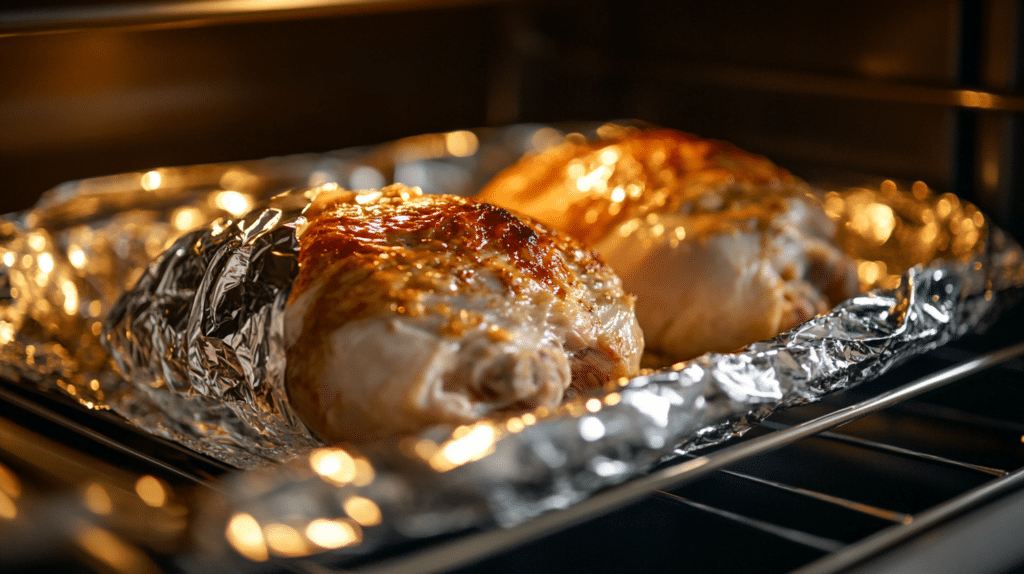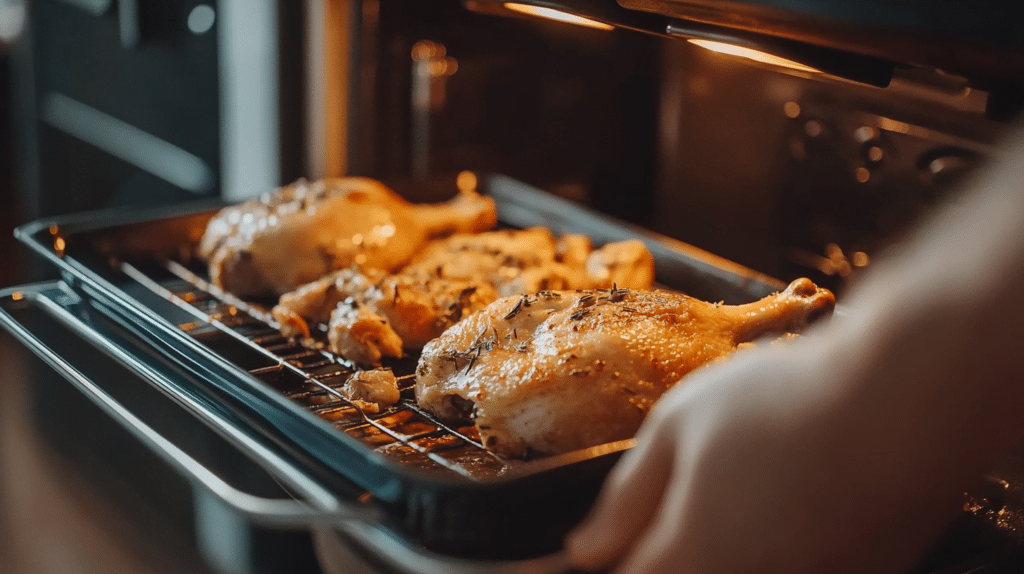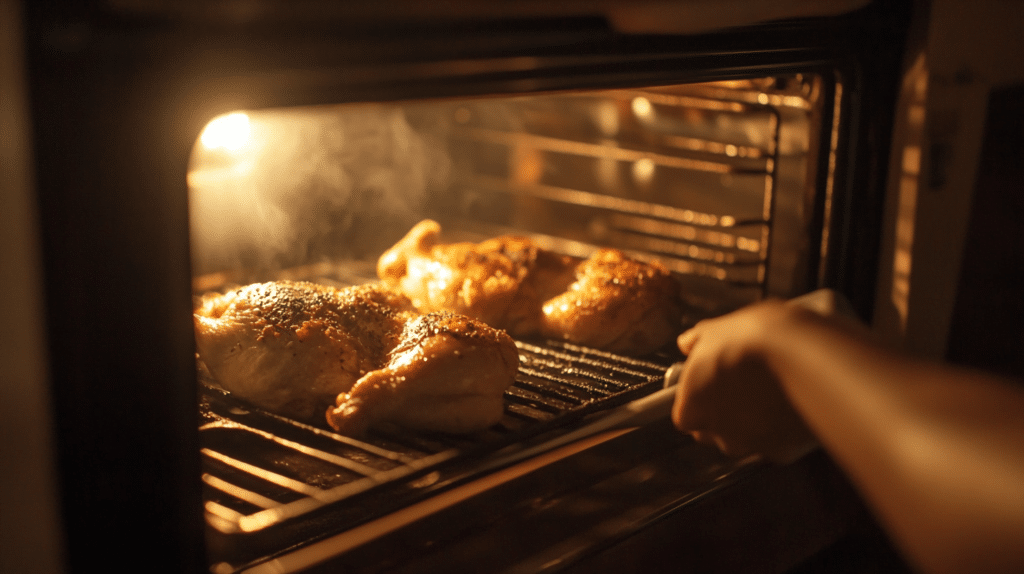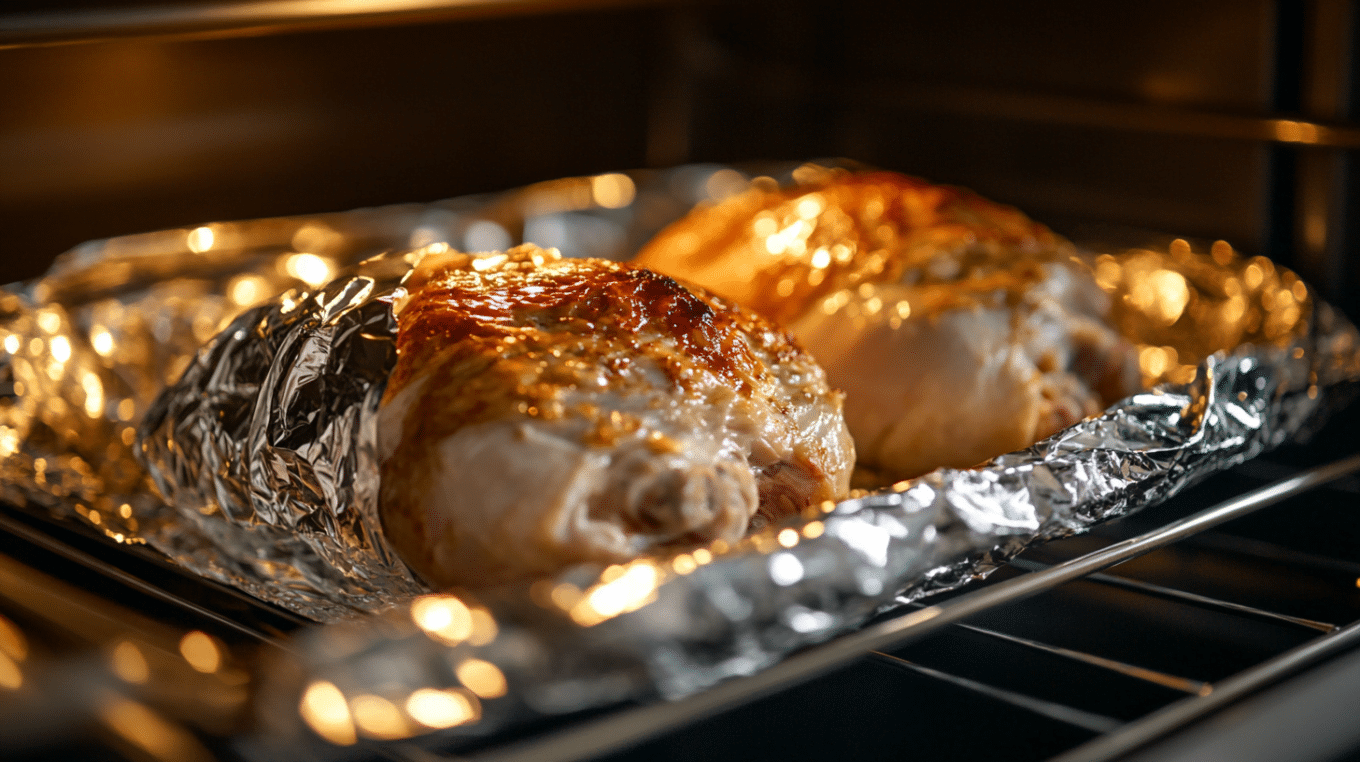Keeping cooked chicken warm without drying it out can be tricky. Whether you’re preparing a family dinner or hosting a gathering, timing all the dishes to be ready simultaneously is often challenging.
Many home cooks struggle with maintaining the perfect temperature of their cooked chicken while finishing other parts of the meal.
This article will provide tips and techniques to keep your chicken warm and juicy using your oven.
We’ll explore the ideal temperature settings, discuss how long you can keep chicken warm without compromising its quality, and share methods to prevent it from drying out.
By the end of this guide, you’ll have the knowledge to serve perfectly warm, moist chicken every time, no matter how complex your meal preparation becomes.
How to Keep Chicken Warm in The Oven

After cooking a delicious chicken dish, maintaining its warmth is crucial for preserving flavor and texture.
Setting your oven to 200°F (93°C) provides an ideal environment for keeping cooked chicken warm without overcooking it. This temperature helps retain moisture and flavor, ensuring your chicken remains appetizing.
To further protect the chicken, loosely tent it with foil. This creates a barrier that traps heat while allowing some air circulation, preventing the skin from becoming soggy.
However, be mindful of timing. Even at this low temperature, leaving chicken in the oven for too long can lead to dryness.
Aim to keep it warm for no more than 20-30 minutes to maintain its juicy texture.
By following these simple steps, you can serve perfectly warm, delicious chicken even if other meal preparations take longer than expected.
Tips for Maintaining the Temperature of Cooked Chicken

Cooking chicken to perfection in the oven can be challenging, but with the right techniques, you can achieve it every time.
Here are seven essential tips to help you master the art of oven-cooked chicken.
1. Preheating and Proper Oven Temperature
Start by preheating your oven to 400°F (204°C). This higher initial temperature is key to achieving that desirable crispy exterior on your chicken while maintaining a juicy interior.
The hot oven quickly seals the outside of the chicken, locking in moisture. After about 15-20 minutes, you can lower the temperature to 350°F (175°C) for the remainder of the cooking time.
This two-step process ensures your chicken is cooked evenly throughout without drying out.
2. Positioning in The Oven
The middle rack is the sweet spot for cooking chicken in the oven. It provides the most even heat distribution, allowing your chicken to cook uniformly.
If you’re using multiple racks, it’s important to rotate the pans halfway through cooking.
This rotation helps compensate for any hot spots in your oven, ensuring all pieces of chicken receive equal heat exposure.
3. Choice of Cookware
Your choice of cookware can significantly impact the outcome of your chicken dish. A roasting pan or baking sheet with low sides is ideal as it allows hot air to circulate freely around the chicken.
This promotes even cooking and helps achieve crispy skin all over. If you’re cooking chicken pieces rather than a whole bird, consider using a cast-iron skillet.
It can be reheated in the oven, providing a nice sear when you add the chicken, and its heat retention properties contribute to even cooking.
4. Avoid Overcrowding
Giving your chicken enough space in the pan is crucial for proper cooking. When pieces are too close together, they steam rather than roast, resulting in soggy skin and uneven cooking.
As a rule of thumb, leave about an inch of space between each piece of chicken. If you’re cooking for a crowd, it’s better to use multiple pans or cook in batches.
This might take more time, but the improved results are worth the extra effort.
5. Basting for Moisture
Basting is a technique that can elevate your chicken from good to great. Every 20-30 minutes, quickly open the oven and spoon the pan juices over the chicken.
If you want to add extra flavor, you can create a basting liquid with melted butter, herbs, and a splash of lemon juice.
However, be mindful that opening the oven too frequently can lead to temperature fluctuations, so try to be quick and efficient when basting.
6. Using a Meat Thermometer
A good meat thermometer is an invaluable tool for perfecting chicken every time.
Insert it into the thickest part of the meat, avoiding bones, as they conduct heat differently and can give a false reading. The safe internal temperature for chicken is 165°F (74°C).
Remember, the temperature will continue to rise slightly during the resting period, so you can remove the chicken from the oven when it reaches 160°F (71°C).
7. Resting Period
After your chicken reaches the right temperature, resist the urge to cut into it immediately. Let it rest for 5-10 minutes for smaller pieces or up to 20 minutes for a whole bird.
During this time, the juices redistribute throughout the meat, making it more tender and flavorful.
If you cut into the chicken too soon, those flavorful juices will end up on your cutting board instead of in your meal.
To keep the chicken warm during this resting period, tent it loosely with aluminum foil.
Common Mistakes to Avoid While Maintaining the Temperature

- Opening the Oven Door Frequently: Repeatedly opening the oven door causes significant temperature drops, leading to uneven cooking. Each opening can decrease the temperature by 25°F (14°C) or more. This results in inconsistent cooking and can affect the chicken’s quality.
- Ignoring Carryover Cooking: Carryover cooking continues after the chicken is removed from the oven, potentially leading to overcooking. The internal temperature can rise by 5-10°F (3-6°C) during resting. To avoid dry chicken, remove it from the oven when it’s about 5°F below the desired final temperature.
- Incorrect Temperature Settings: Setting the wrong oven temperature can lead to dry, overcooked chicken or undercooked, unsafe meat. High temperatures cook the exterior too fast, while low temperatures cause slow, uneven cooking. Use an oven thermometer to ensure accuracy.
Conclusion
To wrap up, mastering the art of keeping chicken warm in the oven is key to serving a delicious and safe meal.
Remember to maintain the right temperature, use foil wisely, and avoid common pitfalls like frequent oven opening or ignoring carryover cooking.
By following these tips, you’ll ensure your chicken stays juicy, flavorful, and at the perfect serving temperature.
Now that you’ve acquired this knowledge, why not put it into practice? Try roasting a whole chicken for your next family dinner or gathering.
Experiment with different herbs and seasonings to create your signature dish. And don’t forget to use a meat thermometer for precise results as well.
We’d love to hear about your chicken-roasting successes! Share your experiences or ask any questions in the comments below.
Happy Cooking!
Frequently Asked Questions
How Do You Keep Chicken Warm While Resting?
To keep the chicken warm while resting, loosely tent it with aluminum foil. This helps retain heat while allowing excess steam to escape, preventing the skin from becoming soggy.
How Do I Make Sure My Chicken is Fully Cooked?
Use a meat thermometer to check that the chicken’s internal temperature reaches 165°F (74°C) at the thickest part. The meat should be white, not pink, and the juices should run clear.
Is It Ok to Reheat Chicken in the Oven?
Yes, it’s safe to reheat chicken in the oven. Preheat to 350°F, place chicken in a baking dish with a bit of broth, cover with foil, and heat until it reaches 165°F internally.




